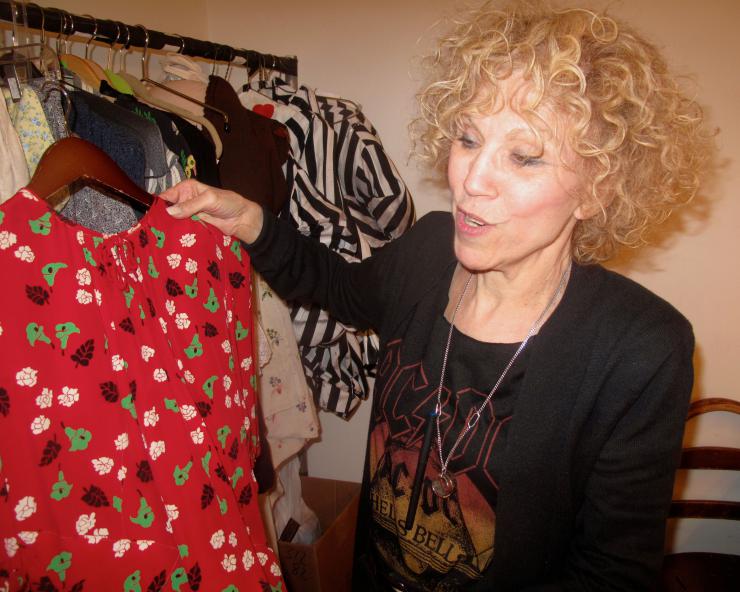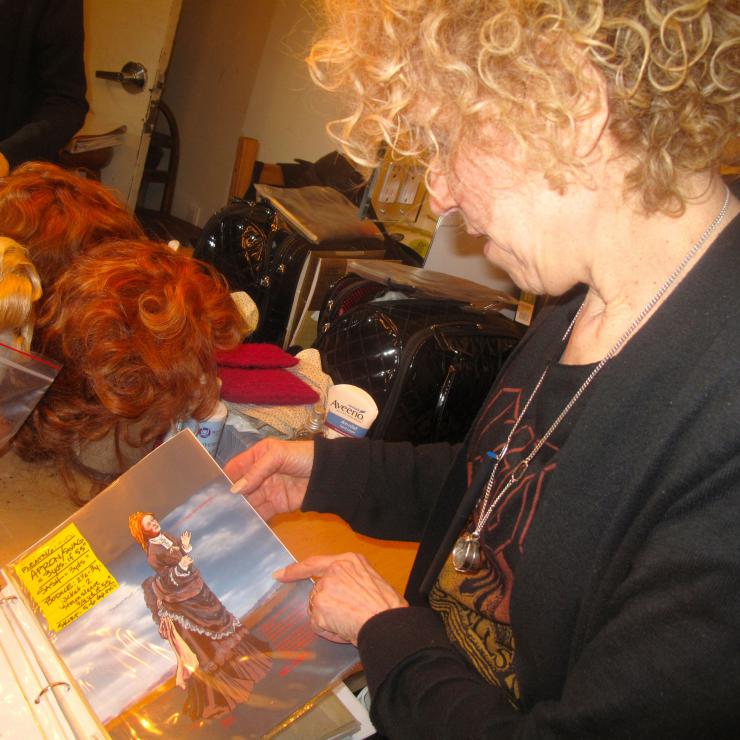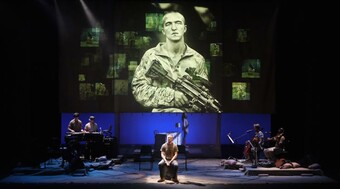Carrie Robbins, from celebrated Broadway Costume Designer to Determined Off-Off Broadway Playwright

Carrie Robbins designed the costumes for the first play that Meryl Streep performed on Broadway, for the original production of Grease, and for more than thirty other shows on Broadway. But there came a time, shortly after her husband died, when she felt costume designing just wasn’t enough.
“Sometimes,” she thought, “the most important decision I make as a costume designer is: ‘Should I make this out of silk charmeuse or should I make it out of silk crepe?’” Now she says, “I began to see that what my husband did was better than what I was working on.”
Her husband was a physician, then a writer. Carrie Robbins decided to adapt his short stories for the stage. Robbins, who began working as a costume designer on Broadway nearly half a century ago, is now making her debut as a playwright at HERE, with two one-act plays entitled Sawbones and The Diamond Eater, running May 21 through June 7.
They are grim dramas, one focused on doctors who performed amputations during the Civil War, the other concerning the medical experiments at a Nazi concentration camp. Both, she says, are based on true stories.
"There's A Field Called Theater Design"
Carrie Fishbein grew up in Baltimore, Maryland knowing that she liked to draw, and that she liked the theater. When she went to college at Penn State, she took a double load of courses, in art and in theater, until a professor pointed out to her that she could combine her two interests; “there’s a field called theater design.”
By the time she went to the Yale School of Drama, she didn’t know which kind of theater designer she wanted to become. The sexist head of the set design department in effect made the decision for her. “He felt it wasn’t a field for women, because a set designer has to be able to speak to the carpenters and the other men in the shop.” She escaped to costume design.
She got her first job as a costume designer on Broadway at age 25. She was nominated for her first Tony before she was 30, for Grease, which started out as a low-budget musical Off-Broadway: “I remember making the poodle skirts out of a pink bathmat that was in my bathroom.”

Her most ambitious show on Broadway was probably Irving Berlin’s White Christmas, for which she had to design so many costumes, “I stopped counting when it got to 300.” Two years ago she received the TDF/Irene Sharaff Lifetime Achievement Award for Costume Design.
You don’t spend a lifetime in a field without having some stories to tell, and Robbins tells hers with particular zest, occasionally accompanied by spontaneous drawings—how the jester’s hat she designed for Hector Villechaize brushed against the live candles from the set and caught on fire; how an actor’s starched white shirt stuck out prominently from his unzippered pants, turning the drama he was in into an unintended farce; how she created fake bosoms for Tovah Feldshuh in Yentl, so she could prove on stage she wasn’t a man but not offend the Orthodox in the audience.
But her stories, she says, pale besides the ones that her husband Richard D. Robbins came home with every night. He was a natural-born raconteur, but he was something more than that. Robbins had gone to Harvard with the idea of becoming a writer, and when he retired early from his profession as a colorectal surgeon, his wife urged him to take up the pen again. He published more than 70 short stories, to some acclaim. Then little more than two years into his new career, abruptly, he was diagnosed with pancreatic cancer; he died eight months later.
For the past seven years, Carrie Robbins has been working to bring some of his stories to the stage, serving in effect as producer as well as playwright. Although she had no direct experience as a playwright, she says, “Costume designers are storytellers. We tell a story within the larger story, our choice of fabric determining whether it’s soft or fluid or crisp; how the cast members walk; how they look. To me, it felt logical. Plenty of people have thought otherwise. Somebody said ‘you could get a writing partner.’ But, since my husband had written these stories, I felt that I had a partner.”
Although she had no direct experience as a playwright, she says, 'Costume designers are storytellers. We tell a story within the larger story...'
The Diamond Eater was a story told to her husband by one of his patients, a former jeweler who had been the victim of the Nazi medical experiments. According to the story that he had told his doctor decades later, he had survived in part by swallowing a handful of diamonds in order for them to escape detection, so that he could use them as barter. Sawbones was based on a story picked up by her husband’s father, Joseph Robbins, who was also a surgeon, and a collector of Civil War memorabilia. The play focuses on a free black man serving as an apprentice surgeon, who rescues a wounded Rebel soldier, a teenager, whose leg must be amputated.
“You can't be squeamish for these stories,” Robbins concedes, “but many have found them ultimately positive, regenerative, uplifting.” To adapt them, she sought advice from playwright David Ives, who had written the book for White Christmas. “He told me you must allow the characters to talk”—to replace narrative with dialogue. “The problem was I was hearing the voice of my husband telling the story. Every preposition he wrote was precious to me.”
She asked actors whom she had befriended over the years to participate in a number of readings, “so I could hear what I’d written. Readings are the New York City standard for people interested in doing plays.” What she ultimately needed, she felt, was a full production—and that included costumes. She hired herself as the costume designer.
It was clear to her from the start that the production would be Off-Off Broadway. “I would never have any opportunity, or any thought, to write for Broadway. The material that I’m interested in would never be of interest on Broadway.”
But her approach to the costume design differs little.
On the day of the final fitting, which is designed to make sure “that all the costumes are helpful,” Robbins took a visitor to the dressing room where most of the 25 costumes for the show hung from a rack. She took one out that she said was dated from 1885. “I can tell from the cut. The fabric used to be called glazed chintz, but now the glaze is all gone.” She took out another, from the 1940s, delicately handling the seams and the trim, and explaining the history of the garment, and how it reflected its era. “A lot of the pieces are from my own collection.” She couldn’t find authentic uniforms of concentration camp prisoners, “so we had to make them; now we have to make them dirty.”

She opened the design book full of sketches and photographs that she had put together for the plays. There were historical photographs of soldiers in the Civil War, prisoners in concentration camps, a painting by Winslow Homer (in order to create the wheat on the set). There was also page after page of elaborate, vivid sketches that Robbins had drawn, most in full color, of the characters and the clothing.
The book was no different from what she would put together for Broadway.
“You solve the design issues—and then you apply the solutions based on your budget. I believe that drawing is thinking. Drawing is communicating.”
And drawing and designing costumes, whatever she might say, is still very clearly something she loves.








Comments
The article is just the start of the conversation—we want to know what you think about this subject, too! HowlRound is a space for knowledge-sharing, and we welcome spirited, thoughtful, and on-topic dialogue. Find our full comments policy here
For info about the show and to hear some music from it: www.DaysOfTheGiants.com